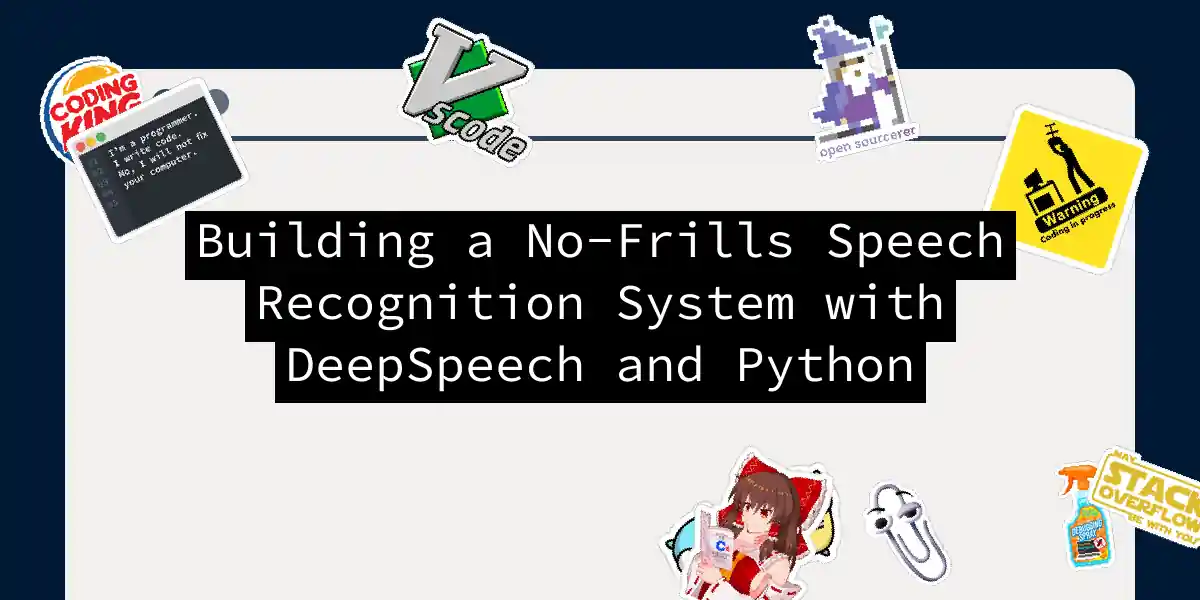The Whispering Code: Making Machines Listen
Speech recognition feels like modern wizardry – you talk, and machines obediently transcribe your words. But unlike magic wands, we have DeepSpeech, Mozilla’s open-source speech-to-text engine that turns audio waves into readable text. Let’s build a system that listens more attentively than my dog when he hears the treat jar open.
DeepSpeech Under the Hood
DeepSpeech uses end-to-end deep learning to convert audio directly to text, skipping intermediate representations like phonemes. Imagine teaching a parrot to transcribe Shakespeare – that’s essentially what we’re doing, minus the feathers.
This architecture handles variable-length inputs beautifully, much like how humans understand both quick quips and dramatic monologues.
Setting Up Your Digital Listener
Prerequisites
- Python 3.6+ (DeepSpeech is picky about versions)
- DeepSpeech package:
pip install deepspeech - Pre-trained models:
wget https://github.com/mozilla/DeepSpeech/releases/download/v0.9.3/deepspeech-0.9.3-models.pbmm
wget https://github.com/mozilla/DeepSpeech/releases/download/v0.9.3/deepspeech-0.9.3-models.scorer
Pro tip: These models have been trained on 8,000+ hours of voice data – that’s longer than all Lord of the Rings extended editions combined!
From Soundwaves to Text: Basic Transcription
Let’s transcribe an audio file first – like dipping toes before diving into real-time streams.
import deepspeech
model = deepspeech.Model('deepspeech-0.9.3-models.pbmm')
model.enableExternalScorer('deepspeech-0.9.3-models.scorer')
with open('audio.wav', 'rb') as f:
audio_data = f.read()
text = model.stt(audio_data)
print(f"Transcription: {text}")
Note: Audio must be 16kHz, 16-bit mono PCM – the sonic equivalent of a plain bagel.
Real-Time Speech Recognition: The Main Event
Now for the party trick: live transcription! This code listens to your microphone and transcribes on-the-fly.
import deepspeech
import numpy as np
from halo import Halo
from vad_audio import VADAudio # Voice Activity Detection
# Initialize model
model = deepspeech.Model('deepspeech-0.9.3-models.pbmm')
model.enableExternalScorer('deepspeech-0.9.3-models.scorer')
# Configure audio input
audio_stream = VADAudio(
aggressiveness=3,
input_rate=16000
)
print("Listening... (Press Ctrl+C to stop)")
spinner = Halo(spinner='dots')
audio_generator = audio_stream.vad_collector()
context = model.createStream()
for frame in audio_generator:
if frame is not None:
spinner.start()
audio_buffer = np.frombuffer(frame, np.int16)
context.feedAudioContent(audio_buffer)
else:
spinner.stop()
text = context.finishStream()
print(f"\nRecognized: {text}")
context = model.createStream()
Key components:
- VADAudio: Filters silent periods (so your system doesn’t transcribe awkward pauses)
- Streaming API: Processes audio in chunks
- Halo spinner: Because waiting without a spinner is like a joke without a punchline
Performance Tips from the Trenches
- Scorer matters: The language model scorer improves accuracy by ~10-15% – don’t skip it!
- Audio quality: USB condenser mic > laptop mic (unless you enjoy transcribing keyboard clicks)
- Handling errors: Wrap recognition in try/except blocks – because sometimes it hears “turn on the lights” as “burn all the knights”
try:
text = context.finishStream()
except Exception as e:
print(f"Recognition error: {e}")
context = model.createStream()
When to Call the Speech Recognition Cavalry
While DeepSpeech is powerful, rolling your own solution has tradeoffs:
| Approach | Pros | Cons |
|---|---|---|
| DeepSpeech | Free, customizable | Complex setup, requires tuning |
| Cloud APIs | Simple implementation | Costs money, privacy concerns |
For many applications, solutions like AssemblyAI offer faster implementation with higher accuracy out-of-the-box – like using a luxury car versus building one from scrap metal.
Conclusion: Your Digital Eavesdropper is Ready
We’ve built a system that can transcribe everything from dinner orders to dramatic poetry readings. The complete project includes:
- Voice activity detection to ignore silence
- Real-time streaming transcription
- Context-aware decoding Remember: Speech recognition is like teaching a toddler – it might misinterpret “I need help” as “I eat kelp” initially. But with patience and tuning, you’ll create systems that make even Siri raise a virtual eyebrow. Final thought: In 100 years, historians might study our voice assistants and wonder why so many 21st-century humans asked about the weather 15 times daily.
